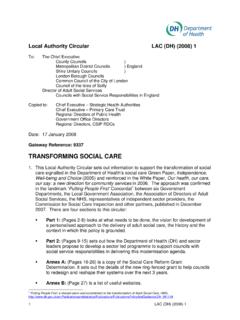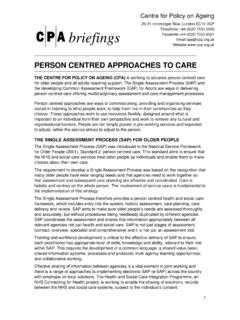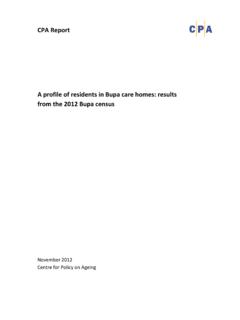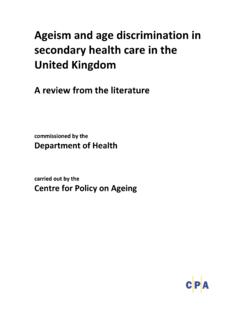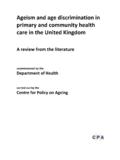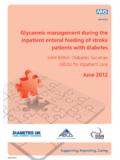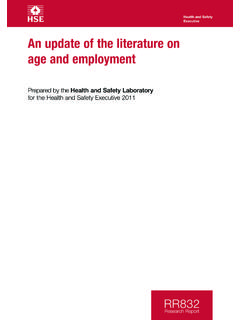Transcription of The prevention of urinary tract infections - CPA
1 Centre for Policy on Ageing Rapid review March 2014 The prevention of urinary tract infections Background urinary tract infection (UTI) is one of the most commonly acquired bacterial infections . It is the second most frequent bacterial infection in residents of long-term care facilities. Most infections are asymptomatic, with a prevalence of asymptomatic bacteriuria of 15% 50% among care home residents (Nicolle, 2013; Nicolle, 2000). Summary and key findings The use of antibiotics has generally been shown to be effective in the prevention of recurrent urinary tract infection. A 3-day course of antibiotics may not be significantly less effective than a 7-day course (Vogel et al, 2004) and, since the over-use of antibiotics is to be avoided to maintain their overall effectiveness, other solutions have been sought. One study (Bleidorn et al, 2010) has shown that treating symptoms with ibuprofen is not significantly less effective than the use of antibiotics.
2 Probiotic interventions have shown variable results in preventing the recurrence of UTIs depending on the type of probiotic used. Lactobacillus rhamnosus GR-1 and Lactobacillus reuteri RC-14 may be effective but Lactobacillus GG drink less so. A number of small scale studies, over the years, have shown that cranberry derivatives, particularly tablets, and to a lesser extent juice, can be effective in preventing UTI, particularly for people at higher risk. A recently updated systematic review of cranberry treatments (Jepson, Williams and Craig, 2012) has however concluded that cranberry juice is not as effective as previously thought and suffers from a very high withdrawal/dropout rate. Other interventions that may be effective include oral immunotherapy with Uro-Vaxom Escherichia coli (E. coli) extract, the use of vaginal oestrogens and HA-CS intravesical instillations. urinary tract infection is commonly associated with the use of catheters in care homes and hospitals.
3 Guidelines to prevent infection indicate that the most effective measure is to avoid the use of catheters wherever possible (not using them as a routine intervention), to constantly monitor their use and to remove catheters at the earliest opportunity. Alternative catheter designs and the use of anti-microbial materials to reduce the formation of biofilm show promise but have not yet been conclusively proved to be Centre for Policy on Ageing Rapid review March 2014 Review of evidence Pagea) Reviews, overviews and comparative studies 3 b) The use of antibiotics 8 c) The use of probiotics 15 d) Cranberry derivatives 18 e) Other interventions 31 f) Catheter acquired urinary tract infections (CAUTI) 36 The reviewed evidence is listed in reverse chronological order with the most recent evidence first. 2 Centre for Policy on Ageing Rapid review March 2014 a) Reviews, overviews and comparative studies Study Findings Eells S J, Bharadwa K, McKinnell J A and Miller L G (2014) Recurrent urinary tract infections Among Women: Comparative Effectiveness of 5 prevention and Management Strategies Using a Markov Chain Monte Carlo Model, Clinical Infectious Diseases 58 (2) : 147-160 A systematic literature review of management of women experiencing 3 or more UTIs per year was carried out.
4 The study then developed a Markov chain Monte Carlo model of recurrent UTI for each management strategy with 2 or more adequate trials published. The model simulated a cohort that experienced 3 UTIs/year and a secondary cohort that experienced 8 UTIs/year. Model outcomes were treatment efficacy, patient and payer cost, and health-related quality of life. Five strategies had 2 or more clinical trials published: (1) daily antibiotic (nitrofurantoin) prophylaxis; (2) daily estrogen prophylaxis; (3) daily cranberry prophylaxis; (4) acupuncture prophylaxis; and (5) symptomatic self-treatment. In the 3 UTIs/year model, nitrofurantoin prophylaxis was most effective, reducing the UTI rate to UTIs/year, and the most expensive to the payer ($821/year). All other strategies resulted in payer cost savings but were less efficacious. Symptomatic self-treatment was the only strategy that resulted in patient cost savings, and was the most favourable strategy in term of cost per quality-adjusted life-year (QALY) gained.
5 Conclusions: Daily antibiotic use is the most effective strategy for recurrent UTI prevention compared to daily cranberry pills, daily estrogen therapy, and acupuncture. Cost savings to payers and patients were seen for most regimens, and improvements in QALYs were seen with all. 3 Centre for Policy on Ageing Rapid review March 2014 Beerepoot M A J, Geerlings S E, van Haarst E P, van Charante N M and ter Riet G (2013) Nonantibiotic Prophylaxis for Recurrent urinary tract infections : A Systematic Review and Meta-Analysis of Randomized Controlled Trials, The Journal of Urology 190 (6) : 1981-1989 This review identified 5,413 records and included 17 studies with data for 2,165 patients. The oral immunostimulant OM-89 decreased the rate of urinary tract infection recurrence (4 trials, sample size 891, median Jadad score 3, RR , 95% CI ) and had a good safety profile. The vaginal vaccine Urovac slightly reduced urinary tract infection recurrence (3 trials, sample size 220, Jadad score 3, RR , 95% CI ) and primary immunization followed by booster immunization increased the time to reinfection.
6 Vaginal estrogens showed a trend toward preventing urinary tract infection recurrence (2 trials, sample size 201, Jadad score , RR , 95% CI ) but vaginal irritation occurred in 6% to 20% of women. Cranberries decreased urinary tract infection recurrence (2 trials, sample size 250, Jadad score 4, RR , 95% CI ) as did acupuncture (2 open label trials, sample size 165, Jadad score 2, RR , 95% CI ). Oral estrogens and lactobacilli prophylaxis did not decrease the rate of urinary tract infection recurrence. Authors conclusions: The evidence of the effectiveness of the oral immunostimulant OM-89 is promising. Although sometimes statistically significant, pooled findings for the other interventions should be considered tentative until corroborated by more research. Nicolle L E (2013) urinary tract infection in long-term care facilities, Healthcare Infection 19 (1) : 4-12 Asymptomatic bacteriuria and pyuria are pervasive in the long-term care population.
7 Optimal management of urinary infection for residents of long-term care facilities requires knowledge of the unique features of the infection in this setting, together with critical evaluation of each episode of potential urinary infection in the individual resident. The author carried out a non-structured review of current knowledge and recommendations relevant to urinary infection in long-term care facilities. urinary infection is the second most common infection occurring in long-term care facility residents. For residents without chronic indwelling catheters, acute, localising, genitourinary symptoms should be present to support a clinical diagnosis of symptomatic infection. Inappropriate antimicrobial use for urinary tract infection, particularly treatment of asymptomatic bacteriuria and prophylaxis of urinary infection, is a consistent observation in reviews of antimicrobial use in these facilities. Management approaches to improve treatment include observation and reassessment when symptoms are questionable or the diagnosis is unclear, limiting the use of chronic indwelling catheters, and early identification of complications, such as obstruction, of indwelling catheters.
8 Conclusions: Clinical diagnostic imprecision and a high prevalence of asymptomatic bacteriuria means these infections are over-diagnosed and over-treated, leading to adverse events from excess antimicrobial use. Antimicrobial stewardship programs to improve antimicrobial use for this indication need to be developed in long-term care facilities. 4 Centre for Policy on Ageing Rapid review March 2014 McMurdo M E T, Argo I, Phillips G, Daly F and Davey P (2009) Cranberry or trimethoprim for the prevention of recurrent urinary tract infections ? A randomized controlled trial in older women, Journal of Antimicrobial Chemotherapy 63 (2) : 389-395 To compare the effectiveness of cranberry extract with low-dose trimethoprim in the prevention of recurrent urinary tract infections (UTIs) in older women. One hundred and thirty-seven women with two or more antibiotic-treated UTIs in the previous 12 months were randomized to receive either 500 mg of cranberry extract or 100 mg of trimethoprim for 6 months.
9 There were 17/137 (12%) withdrawals from the study, 6/69 (9%) from the cranberry group and 11/68 (16%) from the trimethoprim group (P = ), with a relative risk of withdrawal from the cranberry group of (95% CI: , ). Thirty-nine of 137 participants (28%) had an antibiotic-treated UTI (25 in the cranberry group and 14 in the trimethoprim group); difference in proportions relative risk (95% CI: , ) P = The time to first recurrence of UTI was not significantly different between the groups (P = ). The median time to recurrence of UTI was days for the cranberry group and 91 days for the trimethoprim group (U = 166, P = ). Conclusions: Trimethoprim had a very limited advantage over cranberry extract in the prevention of recurrent UTIs in older women and had more adverse effects. 5 Centre for Policy on Ageing Rapid review March 2014 Fihn S D (2003) Acute Uncomplicated urinary tract Infection in Women, New England Journal of Medicine 349 (3) : 259-268 This study presents an overview of urinary tract infection: The probability of cystitis in a woman with dysuria, urinary frequency, or gross hematuria is about 50 percent in primary care settings.
10 Symptoms suggesting vaginitis or cervicitis, such as vaginal irritation or discharge, reduce the likelihood of a diagnosis of cystitis by about 20 percent. Specific combinations of symptoms ( , dysuria and frequency without vaginal discharge or irritation) raise the probability of cystitis to more than 90 percent. When a woman who has previously had cystitis has symptoms suggesting a recurrence, there is an 84 to 92 percent chance that an infection is present. The most important risk factors for acute cystitis in young women are a history of previous episodes of cystitis and frequent or recent sexual activity. Celibate women rarely have cystitis. The relative odds of acute cystitis during the 48 hours after sexual intercourse increase by a factor as great as 60. The use of spermicidal agents elevates the odds of infection by E. coli or by S. saprophyticus by a factor of two to three, irrespective of whether the exposure occurs with the use of a diaphragm or a spermicide-coated condom.


